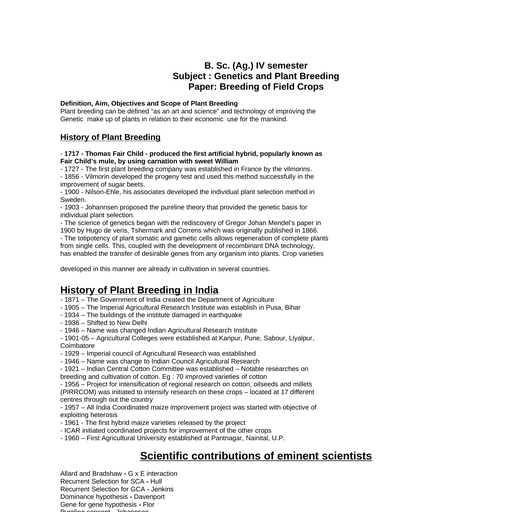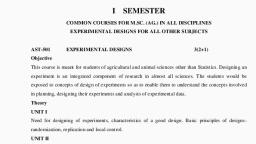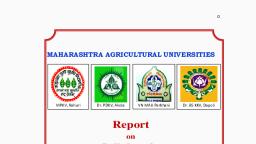Page 1 :
M.Sc. (Ag.) GENETICS AND, PLANT BREEDING, Course Structure- at a Glance, Ist Semester, GPB 501, GPB 502, , PRINCIPLES OF GENETICS AND CYTOGENETICS, PRINCIPLES OF PLANT BREEDING, , GPB 503, , PRINCIPLES OF QUANTITATIVE GENETICS, , GPB 511*, , BREEDING FOR QUALITY TRAITS, EXPERIMENTAL DESIGNS, , AST 501, , 3(2+1), 3(2+1), 3(2+1), 4(3+1), 3(2+1), , IInd Semester, GPB 504, , MUTAGENESIS AND MUTATION BREEDING, GPB 505, CELL BIOLOGY & MOLECULAR GENETICS, GPB 506, POPULATION GENETICS, GPB 512*, GENE REGULATION & EXPRESSION DATA BASE, MANAGEMENT, AST 503, COMPUTER APPLICATION IN AGRICULTURE, IIIrd Semester, GPB 507, HETEROSIS BREEDING, GPB 508, BIO TECHNOLOGY FOR CROP IMPROVEMENT, GPB 509, BREEDING FOR BIOTIC & ABIOTIC STRESS RESISTANCE, AND MAINTENANCE BREEDING CONCEPT OF VARIETY, RELEASE AND SEED PRODUCTION, GPB 513*, DATA BASE MANAGEMENT EVALUATION AND, UTILIZATION OF PCR, IVth Semester, GPB 510, BREEDING LEGUMES, OILSEEDS, FIBER, CROPS, CEREALS,, MILLETS AND SUGARCANE, GPB 516, MASTER’S SEMINAR, GPB 517, MASTER’S THESIS/ special paper, GPB 514*, EXPERIMENTAL DESIGNS IN PLANT BREEDING, GPB 515*, INNOVATIVE APPROACHES FOR CROP IMPROVEMENT, *COMPULSORY FOR MASTER’S PROGRAMME, , 3(2+1), 3(2+1), 3(2+1), 3(2+1), 2(1+1), 3(2+1), 3(2+1), 3(2+1), , 4(3+1), , 3(2+1), 1(0+1), 20, 4(3+1), 4(3+1)
Page 2 :
Dr.B. R. A. UNIVERSITY AGRA, M. Sc. (Ag. ) Genetics &, Plant Breeding, , First Semester, , Course, No, GPB 501, GPB 502, GPB 503, GPB, 511*, AST 501, , Course Title, , Principles of, Genetics &, Cytogenetics, Principles of Plant, Breeding, Principles of, Quantitative, Genetics, Breeding for, Quality Traits, Experimental, Designs, Total Credit Hours, , Second Semester, Course, Course Title, No, GPB 504, GPB 505, GPB 506, GPB, 512*, AST 503, , Credit, Hours, , Marks, , Total, , Theory, , Practical, 30, , Mid, Term, 20, , 3(2+1), , 50, , 100, , 3(2+1), , 50, , 30, , 20, , 100, , 3(2+1), , 50, , 30, , 20, , 100, , 4(3+1), , 50, , 30, , 20, , 100, , 3(2+1), , 50, , 30, , 20, , 100, , 12, Credit, Hours, , Marks, , Total, , Theory, , Practical, , Mutagenesis and, Mutation Breeding, Cell Biology &, Molecular Genetics, Population Genetics, Gene Regulation &, Expression Data, Base Management, , 3(2+1), , 50, , 30, , Mid, Term, 20, , 3(2+1), , 50, , 30, , 20, , 100, , 3(2+1), 4(3+1), , 50, 50, , 30, 30, , 20, 20, , 100, 100, , COMPUTER, APPLICATION IN, AGRICULTURE, , 2(1+1), , 50, , 30, , 20, , 100, , Total Credit Hours, , 11, , 100
Page 3 :
Third Semester, Course, Course Title, No, , Credit, Hours, , Marks, Theory, , Practical, , GPB 507, GPB 508, , 3(2+1), 3(2+1), , 50, 50, , 3(2+1), , 4(3+1), , GPB 509, , GPB, 513*, , Heterosis Breeding, Bio technology for, Crop Improvement, Breeding for Biotic, & Abiotic Stress, Resistance And, Maintenance, Breeding, Concept of Variety, Release and Seed, Production, Evaluation and, Utilization of PCR, Total Credit Hours, , Total, , 30, 30, , Mid, Term, 20, 20, , 100, 100, , 50, , 30, , 20, , 100, , 50, , 30, , 20, , 100, , 9, , Fourth Semester, Course Course Title, No, , Credit, Hours, , Marks, Theory Practical Mid, Term, , Total, , GPB 510, , 3(2+1), , 50, , 100, , GPB 516, GPB 517, GPB, 514*, GPB, 515*, , Breeding Legumes,, Oilseeds, Fiber,, crops, Cereals,, Millets and, Sugarcane, Master’s Seminar, Master’s Thesis, Experimental, Designs In Plant, Breeding, Innovative, Approaches For, Crop Improvement, Total Credit Hours, , 30, , 20, , 1(0+1), 20, 4(3+1), , Satisfactory/Unsatisfactory, 50, 30, 20, , 100, , 4(3+1), , 50, , 100, , 24, , 100, , 30, , 20
Page 4 :
M.Sc.(Ag.) GENETICS AND PLANT BREEDING, COURES CONTENT- DETAILED SYLLABUS, GPB 501: PRINCIPLES OF GENETICS & CYTOGENETICS, 3(2+1), THEORY, UNIT I, Beginning of genetics. Cell structure and cell division. Mendel’s laws,, Discussion on Mendel’s paper. Chromosomal theory of inheritance.Multiple, alleles. Gee interactions sex determination .sex-influenced and sex-limited, trait; Linkage-detection, estimation. Recombination and genetic mapping in, eukaryotes. Somatic cell genetics Extra chromosomal inheritance., UNIT II, Population – Mendelian population Random Mating population frequencies of, genes and genotypes causes of change hardy Weinberg equilibrium. Structural, And Numerical Changes In Chromosomes. Nature. Structure And Replication, Of The Genetic Material Organization Of DNA In Chromosomes. Genetic Coad., UNIT III, classical and modern gene concept, genetic fine Structure Analysis, allelic, complementation, split gene, transposable genetic element. overlapping, genes, pseudo gene oncogened, gene families and clusters. Molecular, mechanism of mutation, repair and suppression, bacterial plasmid, gene, expression, gene regulation in Eukaryotes, RNA editing., UNIT IV, Gene isolation, synthesis and cloning genomic and cDNA libraries, PCR based, cloning positional cloning, Nucleic acid hybridization, DNA sequencing DNA, restriction and modification, antisense RNA and ribozymes micro RNAs, editing, UNIT V, Gene silencing genetic of Mitochondria and chloroplast. concept of eugenic, epigenetics. Genetic disorder and behavioral Genetics., UNITVI, Architecture of chromonemata: chromosomes Matrix chromosome., Centromere. secondary construction and telomere: artificial chromosome, construction and its uses special type of chromosomes.cell cycle and cell, division-mitosis and meiosis: differences significance and deviation synapsis., structure and functional of complex and spindle Apparatus anal anaphase, movement of chromosomes and crossing over mechanism and theories of, crossing over recombination models. cytological basis-variation in
Page 5 :
chromosome structure evolutionary significance-introduction to technique for, karyotyping chromosomes bending and painting in situ hybridization and, various applications., Unit VII, structural and numerical variation of chromosome and their applications, symbols and Terminology for chromosome number euploidy haploid diploid, and polyploidy: utilization of aneuploidy engineer in location evolutionary, significance of chromosomal aberrations balanced lethal and chromosome, complex., UNIT VIII, Inter-varietal chromosome substitution polyploidy and role of polyploidy in, crop breeding unitary advantage of autopolyploid vs allopolyploids-role of, and applied in basic and applied aspects of breeding their maintenance and, utilization in gene mapping and gene block transfer alien aditing and, substitution line-utilizationapomixes unitary and genetic problem in crop, with apomixes., UNIT IX, Reversion of autopolyploid to diploid genome mapping in polyploidy, interspecific hybridization and autopolyploid allopolyploid sentences of new, crop rate critical and Jessica hybrid between species with same chromosome, number alien translocation habit between species with different from other, number gene transfer using amphidiploids Bridge species.Fertilization, barriers in crop plant at pre and post fertilization levels in vitro techniques to, overcome that fertilization via in craft chromosome manipulation in wide, hybridization case study problems in case in use of haploid diploid and double, haploid in in Genetics and breeding., PRACTICAL, Laboratory exercise in Probability and chi-square demonstration of genetic, principle using laboratory organism, numerical exercise related to mendelian, principles numerical related to multiple alleles (ABO blood group system)., chromosome mapping using three point test cross tetragonal analysis, including and detection of mutations through Genetic test. Principle, demonstration detection of transgenic in the exposed plant material., visit to, transgenic genetic glass house and learn the practical consideration., Learning and learning and cytogenetics laboratory various Chemicals to be, used for the hybridization in breathing situation practical learning the, cytogenetics laboratory various chemical to be used for fixation dehydration
Page 6 :
and leading staining cleaning etc. microscopy various type of microscopes, observation selection of specimen using microscope repairing specimen for, observation situated preparation and fixing for light microscope study in, serials study on the course of mitosis in the pearl millet studies on the course, of mitosis in onion study on the course of mitosis in serials millets and pulses, and in all seeds using micrometer and studying the pollen grain size in various, crops various method of staining and preparation of temporary and, permanent slides pollen germination in vitro and in Vivo., GPB 502 PRINCIPLE OF PLANT BREEDING, 3(2+1), THEORY, UNIT IHistory of plant breeding objectives of plant breeding characteristic, improved by plant breeding patterns of evolution in crop plants center of, origin biodiversity and its significance., UNIT II, Genetic basis of breathing self and cross pollinated crops including meeting, system and response to selection-nature of variability. component of variation, heritability and genetic advance genotype environment interaction type of, gene action and implication in plant breeding plant introduction and role of, plant genetic resources in plant breeding. Self incompatibility and male, selection in crop plants crop plants and their commercial exploration: concept, of plant ideotype and its role in crop improvement transgressive breeding., UNIT III, pure Line Theory pure line selection and mass selection method line breeding, Pedigree bulb single seed Descent and multiline methods population breeding, in self pollinated crops (diallel selected meeting approach)., UNIT IV, Breeding method in cross pollinated crops population breeding mass, selection and Toubro method S1 and S2 progeny testing provisional selection, skill recurrent selection scheme for inter and intra population improvement, and development of sentences and composite variety hybridized reading and, in breathe in production in in breathe grading approach for improvement of, injuries free production hybrid performance, seed production of hybrid and, their parent varieties of inbreeds., UNIT V, Breeding method in a sexually propagated crop clonal selection apomixes., UNIT VI, Breeding for abiotic and biotic stresses.
Page 7 :
UNIT VII, Cultivar development-testing release and notification maintenance breeding, Participatory plant breeding. plant breeding rights and regulation for plant, variety protection and farmer rights., PRACTICAL, Floral Biology in self and cross pollinated species. selfing and crossing, techniques selection method in aggregation population and evolution of, building material analysis of variance in our destination of heritability and, genetic variance advance maintenance of experimental record learning, techniques in hybrid seed production use using male sterility in field crops., GPB 503 PRINCIPLES OF QUINTITATIVE GENETICS, 3(2+1), THEORY, UNIT I, Mendelian traits vs polygenic traits-nature of quantitative traits and its, inheritance-multiple factor hypothesis-analysis of continuous variation:, variations associated with polygenic traits phenotypic genotype and, environmental-non-allelic interaction nature of gene action additive., dominance acoustics and linkage effect., UNIT II, Principles ofanalysis of various (ANOVA)- expected variance component, random and fixed models: MANOVA. Diplot analysis comparison of mean and, variance of significance., UNIT III, design of plant breeding experiment principle and applications and Diversity, analysis multiple of mythology character analysis Association analysis, phenotypic and genotypic correlation path analysis and a person regression, analysis and principal component analysis selection indices-selection of, parents: simultaneous selection models-concepts of selection-heritability and, genetic advance., PRACTICAL, problems on multiple factors inheritance-partitioning of variance estimation, of heritability and advanced conversing analysis mythology analysis D2, analysis grouping of clusters and interpretation-Covariance analysis clusters, diagrams and plastids diagram of Den drug dendrogram Inter 1st session, correlation analysis analysis percentage progeny regression analysis analysis, method first and second by image on a message I am Ace graphical
Page 8 :
approaches dial analysis and dress up result and d c and d interpretations line, x tester analysis and interpretation for project estimation of heterosis stand, stand standard mid mid parental Centre and better parental heterosis, estimation of inbreeding depression germination mains analysis analytics, path and interpretation estimation of different type of gene action part, equation of static variance and covariance in two components due to, genotypes environment and genotype x environmental inheritance working, out the efficiency of selection method in different population and interesting, presentation by parental matting trial analysis analysis and triple test cross, PTC news app software license and result interpretation advanced biometrical, method for combining ability analysis models in analysis additive effect and, multi multiplicative interaction (AMMI) model., GPB504 MUTAGENESIS AND MUTATION BREEDING, 3(2+1), UNIT I, Mutation and its history nature and classification are mutation spontaneous, and induced mutation micro and micro nutrition free and forced adaptive, adaptive medicine deletion and nutrition in lower and higher organism, UNIT II, mutagenic agents physical and physical Condition Type of source Anion and, non ionizing radiation that is X rays and gamma rays alpha and beta particles, proton neutron and radioactive radiobiology mechanism of action of various, radiation and their biological effects RBE and LET relationship., UNIT III, Effect of mutation in DNA repair mechanism of operating at DNA chromosome, cell and organism lead to the mutation effect symmetry objects and methods, of fitment factor efficiency rotation does dose rate vs chronicle irradiation, requirement a radiation radiation sensitivity and modified proctor external, and internal sources., UNIT IV, chronicle mutagen classification based analogues. antibiotics agent Legend, acridine dyes and other metals and their properties and mode of action does, dose determination and factors affecting chemical mutagens: treatment, method using system and importance other causes of Nutrition of direct and, indirect action., UNIT V, Observation method effects in MI generation plan injured lethality stability, chimeras etc. offering Lotus effect in M2 generation estimation of mutagenic, efficiency and effectiveness.
Page 9 :
UNIT VI, Factor influencing the mutant spectrum genotype type of mutagen and dose, pleiotropic and linkage individual plant based mutation analysis and working, out effectiveness and efficiency in M3 generation ., UNIT VII, Use of mutagens in creating oligo genic and polygenic variation handling of, segregating generations and selection procedures validation of mutants., Mutation breeding for various traits in different crops produced for Micromutation breeding/polygenic mutations: achievement of mutation breeding, varieties released across the word problem associated with breeding., PRACTICAL, Learning the precautions on handling mutagens: dosimetry studies of, different mutagenic agents physical mutagen studies of different mutagenic, agents chemical mutagen learning on radioactive production of source and, isotopes at BRIT. Trombay. learning about Gamma chamber radiation hazards, monitoring safety Regulation and safe transportation of radioisotopes hazard, due to chemical mutagens treating the plant gives a different those are, physical and chemical and learning and communication with an equipment, writing the crop for observation mutagenic efficiency and efficiency study of, your my generation find out to be of the study of M1 generation diameter of, the mutation breeding in cereal and pulses achievement more and analysis, mutation breeding in cheap and cotton achievements and opportunities, mutation breeding in forage transform for detection amputation for college, any trades in M2 and M3 generation., GPB 505: CELL BIOLOGY AND MOLECULAR GENETICS, 3(2+1), THEORY, UNIT I, Ultrastructure of the cell differences between Eukaryotic and prokaryotic cell, macromolecules, structure and function of cell well nuclear membrane and, plasma membrane: Cellular organelles nucleus plastic chloro/chromoplast., mitochondria endoplasmic reticulum Golgi complex. Lysosomes peroxisomes., UNIT II, ultrastructure and function of micro media chloroplast and their poly, photosynthetic organisms in interphase nucleus structure and chemical, composition cell division and physiological of cell division.
Page 10 :
UNIT III, historical background of molecular Genetics genetic material in organism, structure and properties of nuclear acid., UNIT IV, DNA from valuation type of government unique and repeated sequence, organelles genomes genomes amplification and its significance., Practical, morphological and Gram staining of natural bacteria cultivation of bacteria in, synthetic medium determination of growth rate and doubling time a bacterial, cell in culture promotion of the to your face by self determination of syllable, protein content in the bacterial culture isolation purification and propagation, a bacterium studio lighting lighting cycle of bacteriophage by One segment, definition of latent period and red size phages per cell., GPB 506 POPULATION GENETICS, 3(2+1), THEORY, UNIT I, population property and population mendelian population genetic, constitution of population growth time space age structure etc. maintenance, system random mating population frequency of jeans and type causes of, change population size difference in fertility and variability mutation and, mutation., UNIT II, hardy-weinberg equilibrium Hardy weinberg law proof application of the, hardy-weinberg law: Test of Hardy weinberg equilibrium., UNIT III, multiple alleles, more than one locus use of gene and genotype frequencies, equilibrium and field population labour inter precipitation changes in gym, you can see me migration mutation current and non recurrent selection, selectionflavouring heterozygote over over-dominance for fitness., UNIT IV, non random mating something in wedding Corporation parametric index, summiting assertive and discuss automatic Pedigree population and close, inbreeding effects in Breeding and sib matting in cross pollinated crop., UNITV, Gene substitution breeding values genetic drift Genetic slippage Co adopted in, complex advantage organism of James School heterozygote advantage, survival oppressive and Allele in population.
Page 11 :
Practical, genetic exercise on Probability estimation of gene pregnancy exercise and, factors affecting gene frequency estimation of average effect of genes, substitution and breathing value exercise on in wedding and linkage, disequilibrium join skills test are different matting design estimation of, different population parameter for experimental data., GPB 507 HETEROSIS BREEDING, 3(2+1), THEORY, UNIT 1, historical aspects of heterosis nomenclature and definition of heterosis in, natural population and population genetic consequence of self and crossing in, self pollinated and cross pollinated and propagated crops, UNIT II, mendelian and post mendelian ideas theory of inheritance genetics logical and, biochemical evolutionary concept and estimation of heterosis., UNIT III, prediction of heterosis from various crosses inbreeding depression frequency, of inbreeding and residual address in F2 segregation population of inbreeding, in Explorer exploitation of heterosis case study relationship between genetic, distance and expression of heterosis case study divergence in genetic distance, analysis morphological and Molecular genetic distance in the protecting, process development of Agro Tech foods in oblique genetic stock in, inbreeding, there improvement for increasing heterosis., UNIT IV, type of male sterility and used in addresses building maintenance, transfer, and restore ration of different types of nail specialty use of self incompatibility, in development of hybrid hybrid seed production system three line to line and, one line development of integrated and parental line a b and R lines functional, male sterility miracle exploration of heterosis maintenance breeding of, parallel line in hybrid, UNIT V, fixation of actresses in self cross and often cross pollinated crop is actually, oblique clonally propagated crops male extra line creation and diversification, in self pollinated or cross pollinated and asexually propagated crops problems, and prospects apomixes in fixing heterosis concept of single line breeding, UNIT VI, creation of male sterility throw genetic engineering and its exploration in, Hyderabad.
Page 12 :
UNIT VII, Heterosis breathing in wheat rice cotton sorghum and oilseed crops., practical, selection indicates and selection differential Calculation and interpretation, male sterility Mel strike line characterization in merit using morphological, restore line identification and diversification of male strike source line, creation in oilseed pulses and cotton problems in creation of cgms line v of, overcoming them estimation of process parameter in self cross and asexually, propagated crops estimation from the various model of addresses parameter, hybrid seed production in field crop an account on the release hybrid their, potential problems and way of overcoming it hybrid breeding at National and, international level., GPB 508 BIOTECHNOLOGY FOR CROP IMPROVEMENT, 3(2+1), THEORY, UNIT I, Biotechnology and its relevance in agriculture definition terminology and, scope in plant breeding., UNIT II, Tissue, culture, history, Callus, suspension culture loan regeneration somatic, embryos and embryogenesis anther culture somatic hybridization technique, Meristem ovary and culture cryopreservation., UNIT III, Technique of DNA isolation, quantification and analysis genotyping, Sequencing technique vectors Vector preparation and cloning. molecular, markers: morphological biochemical and DNA bases marker (RFLP RAPD, AFLP SSR SNPs and ESTs) mapping population, UNIT IV, Molecular mapping and tagging of economic importance trade spectacles tools, in market analysis gene pyramiding., UNITV, marker assisted selection and Molecular breeding genomic for crop, improvement integration function genomic information on agronomically, economically important strait in plant breeding., UNIT VI, Recombinant DNA techniques transgenes method of transformation vector, mediated gene transfer physical method of gene transfer production of
Page 13 :
genetic genetic plant in various field crops cotton wheat Maize rice soyabean, sugar cane comerical commercial release., UNIT VII, Biotechnology application application in male sterility oblique hybrid, breathing molecular pharming., UNIT VIII, GMO, International regulation of gene regulatory procedure in other countries, including India other legal and social issue Intel Intel culture property rights., UNIT IX, nanotechnology and irrigation in crop improvement program., practical, requirement for plant tissue culture laboratory techniques in plant tissue, culture media components and media preparation aseptic manipulation of, various explained observation on the quantum Quantum minutes walking in, media interpretation in population of explant introduction and plant, regeneration plant regeneration is standardizing the protocols of, regeneration meaning of region rated plants blazing a Greenhouse and, hardening procedure to visit to, micro propagation unit construction of, generator linkage map using computer software., GPB 509 BREEDING FOR BIOTIC AND ABIOTIC STRESS RESISTANCE &, MAINTENANCE BREEDING& CONCEPT OF VARITY RELEASE &, SEED PRODUCTION:, 3(2+1), THEORY, UNIT I, importance of plant breeding wi th special reference to biotic and abiotic, stress resistance classification of biotic stress Mirza pets and disease of, economically important crops concept in insect and pest resistance analysis, and inheritance of the instance variation host defense response to the paper, to the invasion biochemical and Molecular mechanism and induces immunity, and systematic requirement resistance oblique (SAR): host pathogen, interaction reason for gene hypothesis., UNIT II, type of genetic mechanism of resistance to biotic stress horizontal and vertical, resistance in crop plant quantitative resistance oblique adult plant resistance, and slow wrestling the distance measuring plant resistance using plant, fitness. phenotypic screening method for measure pest and disease recording
Page 14 :
of observation correlation the observation using market Atta gene pyramiding, method and their implication., UNIT III, classification of stress stress including factor moisture stress and water, logging and some acidity salinity and alkalinity entity temperature wind etc., stress due to soil factor and mineral toxicity physiological and physical, response Emphasis of abiotic stress in developing reading methodologies., UNIT IV, genetics of abiotic stress resistance gene and genome inbreeding cultivators, suitable for to low water and water logging and from marriage in higher and, lower freezing temperature breathing for resistance to stress caused by, toxicity deficiency and pollutants of contaminants in soil water and, environment. exploitation of wind relative as a source of resistance to biotic, and abiotic factor in laser field crops for disease and insect pest management, achievement., UNITV, variety development and maintenance definition variety cultivar extent, variety essentially their derivate variety independently divide variety, reference variety farmer variety hybrid and population variety testing release, in notification system in India and abroad. DUS testing DUS descriptors for, major crops genetic purity concept and maintenance breeding., UNIT VI, factor responsible for generated duration of variety safeguard during seed, production maintenance of variety in self and cross pollinated crops isolation, distance principle of seed production method of nucleus and breeding seed, production., UNIT VII, generation system of foundation and pulses pulses field pea oil seeds, groundnut sunflower mustard seeds cotton seed certification production seat, Lo and plant variety protection regulation in India and international system., PRACTICAL, phenotypic screen technique for second plants and trees and plants grade to, be observed at a plant and insect level phenotypic screening techniques for, and borders of combination them breathing for Herbicide its resistance, evolution the variable abibl population like RIL. NIL. etc. for pest resistance, unit off screen method for disease caused by fungi and bacteria quality, parameter evolution evolution screening crop for Dog and Potter expense, screening varieties of major crops for acidity and alkalinity their effect and
Page 15 :
breeding strategies.identification of suitable area location for seed production, method and nucleus seed production main characteristics of release and, notified variety hybrid and parent allies identification of importance weed, observation observation level beats deta determination of isolation distance, and planting ratio in different crop seed production technique of variety in, different crops hybrid seed production Technology of important crops., GPB 510 BREEDING CEREALS, MILLETS, SUGARCANE, PULSES,, OIL SEEDS AND FIBERS CROPS:, 3(2+1), THEORY, UNIT I, RICE- evaluation and distribution office for forms wild relatives and Z plus, genetic genetic and relationship objected hybrid rice breeding potential and, outcome aerobic write its simplification and drought resistant breeding., UNIT II, Wheat: Evolution and distribution of apecties and forms-wild relatives and, germplasmcytogenetics and genome relationship. breeding objectives quality, charcters. Biotic and abiotic stress resistance. Exploitation of heterosis., Pearl millet: Evolution and distribution of species and forms wild relatives, and germplasmcytogeneies and genome relationship. Breeding objectives, yield. Quality characters. Biotic and abiotic stress resistance., UNIT III, Maize: evaluation and distribution of species and form wild relatives and, germplasm; cytogenetics and genome relationship - Breeding objectives yield, quality character biotic and abiotic stress resistance: QPM and Bt strategies, and implication., UNIT IV, Sugarcane-evaluation and distribution of species and forms wild relatives, and germplasm: Cytogenetics and genome relationship breeding objective, yield quality characters biotic and abiotic stresses resistance., UNIT V, Distinguishing features of popular released varieties in rice wheat and, sugarcane and their location to be used as touching maintenance of security, nuclear and breeding breed seed production, UNIT VI, Pigeonpea. evaluation and distribution and sleep and forms violated and, applied Genetics and cytogeneticsgenome relationship building objective, build quality characters biotic and abiotic stresses Technology maintenance
Page 16 :
stability fertile and Restaurant line progress mode atICRISAT and other, INSTITUTE., UNIT VII, Chickpea: evolution and distribution of specters and wild relatives and, germplasmcytogenetice and genome relationship. Breeding objectives-yield, quality characters biotic and abiotic stress: protein quality improvement, breeding for anti nutritional factors., UNIT VIII, Groundnut: evaluation and distribution of species and formed by letters and, Jen plant cytogenetics and genome listen for and contain character building, objective biotic and abiotic stresses., UNIT IX, Rapaseed and Mustard: Breeding objectives. utilization of wild relatives for, yield and quality improvement. biotic and abiotic stress: oil quality, characteristics in different oils. Evolution and distribution of species and, forms. wild relatives and germplasm genetics cytogenetics and genome, relationship., SunflowerEcolution and distribution of species and forms: wild relatives, andgermplasm. Cytogenetics and genome relationship hybrid sunflower., constraints and achievements., UNIT X, CottonEvolution of cotton breeding objectives- yield quality characters biotic, and abiotic stress; Development and maintenance of male stenle lines. Hybrid, development and seed production: scenario of Bt cotton. evaluation, procedures are bt.cotton., UNIT XI, Distinguishing features of the released varieties in pulses. Oilseeds and cotton;, Maintenance of seed purity and seed production., Practical, Use of descriptors for catalogumg; Floral biology – emasculation pollination, techniques; Study of range of variation for yield and yield components: Study, of segregating populations in Chickpea. Use of descriptors for cataloguingFloral biology. Emasculation, emasculation pollination techniques in Rapeseed, and Mustard.Floral biology population technique study of range of variation, for ill and field components study of segregation population and their, evaluation Best scanning for specific resistance in of important use descriptor, and logging germplasm maintenance learning on the Standard regulation, system and its use of software for Database Management and retail
Page 17 :
GPB 511 BREEDING FOR QUALITY TRAITS, 4(3+1), THEORY, UNIT I, Genetics of Carbohydrate, protein, fats, vitamins and anti nutritional factor., Breeding for Grain quality parameters in rice and its analysis. Golden rice and, aromatic rice. Breeding strategies and achievements and application in Indian, constext, UNIT II, Breeding for baking qualities in wheet. characteristics to be considered and, breeding strategies. molecular and cytogenetics manipulation for quality, improvement in wheat, UNIT III, Breeding for quality improvement in Sorghum and pearl millet. Quality, protein maize. concept of breeding strategies. genetic Resource Management, for staining creative quality in crops, UNIT IV, Breeding for quality in and pigeon Pea. Breeding for quality in rapeseed and, mustard groundnut and sunflower and minor oilseed Genetic manipulation, for quality improvement IN COTTON, PRACTICAL, Identification of suitable area location for seed production. Ear to row, method and nucleus seed production. main characteristic of release and, notified varieties hybrid and parental line identification of improvement, weed and objective rate determination of isolation distance and planting, ration in different crop production techniques of varieties in different crops, hybrid seed production Technology of improvement crop, GPB 512 GENEREGULATION AND EXPRESSION, 4(3+1), THEORY, UNIT I, Introduction and gene regulation pourpouse and mechanism. level of gene, control, Unit II, coordinated genetic regulation examples - Anthrocyanin and gene families, and maize. genetic and Molecular basis depending on tissue specificity, UNIT III, gene exprssiontransposatation in plants gene expression cloning, transportation tagging light regulated gene expansion model system in
Page 18 :
arabidopsisand maize . paramutation and importing of genes and genomes., UNITIV, Transgene expression and gene silencing mechanism regulatorygenes, horiental and vertical Homologytransformation regulator genes as visible, markers. reporters system to study gene expression. combination gene, control., PRACTICAL, Eukaryotictranscriptionalcontrol single transduction stresses induced gene, expression jeans trips and enhance trips, GPB 513 DATABASE MANAGEMENT EVOLUTION AND, UTILISATION OF PGR, 4(3+1), UNIT I, Statistical technique in management of germplasm: core identification., estimation of sample size during plant exploration impact of sample sampling, on Population structure sequent sampling for variability estimation, estimation of sample size for storage and viability testing., UNIT II, Germplasm documentation basic of computers and operating systems, database management system use of statistical software pictorial and, graphical representation of data, UNIT III, Germplasm management system- Global scenario: genetic variation in crop, plants and management of germplasm collection. limitation in use of, germplasm collection. limitation in use of germplasm collection; necessary of, germplasm: evolution method of identification of usefulgermplasm:, Characterization of germplasm and evolution procedure includingspecifie, traits; Gene market and their use in PGR management., UNIT IV, Management and utilization of germplasm collection: concept of core, collection molecular markers and their use in characterization: Evolution and, utilization of genetic resource: pre breeding/genetic enhancement. utilizing, wild species of Crop improvement, practical, Basis of computer and operating system identification of useful germplasm,, evolution of Cropgermplasm:statically technique in management of, germplasmestimation of sample size for storage and variability testing:
Page 19 :
evolution procedure and experimental protocols(design and their analysis), assignment of Genetic diversity: technique of characterization of germplasm:, molecular markers and their use of characterization., GPB 514 EXPERIMENTAL DESIGN PLANT BREEDING, 4(3+1), UNIT I, principle of experimental design question and accuracy advantage of, replication experimental technical analysis of various fundamental principle, of analysis of variation variance critical difference limitation of the analysis of, variance., UNIT II, statistical analysis and advantage and disadvantage of basic design –, Complexly Randomized Design, Randomized block design Latin square design., UNIT III, Split plot design., UNIT IV, missing plot technique: technique for missing plots. cross overdesign or, switch over trades rotational experiments progeny selection compact family, block design. uniformly trade sampling in field experiment., Practical, Analysis of data generated from compact design randomly block design Latin, square design split plot design missing plot technique analysis of sampling in, field experiment., GPB: 515 INNOVATION APPROACHES IN PLANT BREEDING, 4(3+1), THEORY:, UNIT 1, introduction markers morphological isozymes. DNA marker (RFLP, RAPD,, AFLP, SSR, SNP construction of linkage map use of mapping population (F2, R11.s.N11.s back cross doubled haploids) application advantage application of, molecular markers finger printing. Phylogenetic relationship. Tagging, agronomically traits., Unit II, Transgenic plant application of transgenic Technology antisense RNA, technology, stability of transgenes, integration of transgene in plant breeding
Page 20 :
UNIT III, Biosafety issues of transgenic. somatic hybridization application and, construction somaclonal variation in crop improvement overview and future, prospects, UNIT IV, plant genetic resources, characterization and utilization. Breeding for biotic, stresses resistance, abiotic stress tolerance and nutritional quality apomixes, and its utilization., PRACTICAL, functional Marker reverse genetic approach. Targeting and induces location, lesions in genome(TILLING) ECOTELLING and its application in crop, breeding.



















































